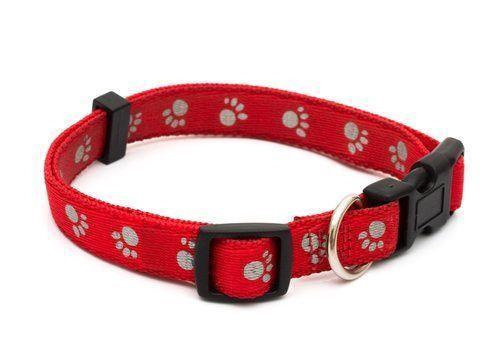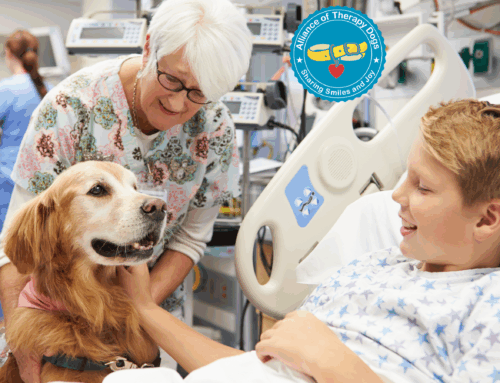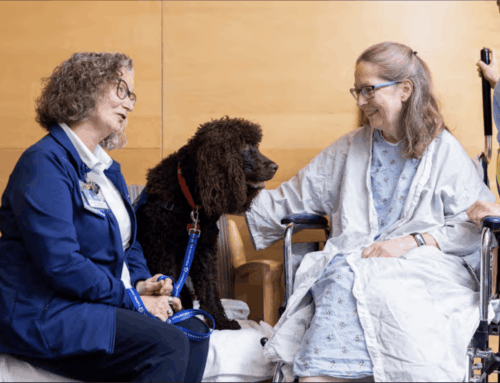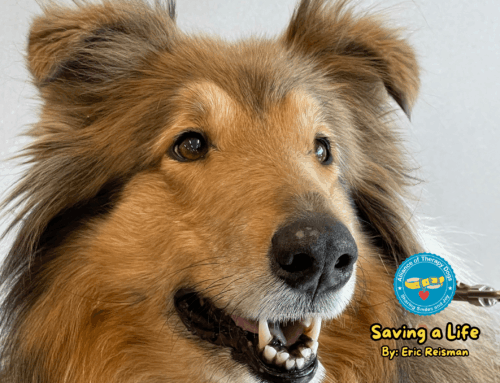Dog training, like many other professions, goes through cycles of fads and changes. Most dog owners now know that swatting a dog on the behind with a newspaper or rubbing his nose in a bathroom accident which he deposited sometime during the day is ineffective to house train. When it comes to behavior modification, like getting your dog to walk nicely on a loose leash by your side, there are many training tools, equipment and “quick fixes” out there. Not all of them are appropriate for nor permitted on a therapy dog visit.
When to Use Training Equipment
Training equipment refers to tools and devices that handlers can use to train dogs more effectively, efficiently, or safely. Equipment can include variations on collars, harnesses, crates, and clickers. Ideally, training equipment is used temporarily to help to teach the dog appropriate behaviors or boundaries, and is removed once the dog has an understanding of the expected behavior. For example, a crate can be used to help house train a dog by placing the dog in the crate whenever it is left unsupervised so as to prevent accidents in the house. Many dogs who are crate trained as puppies can be left loose in a portion of the house as adults because they know the rules about pottying outside. While some training equipment is intended for temporary use, some handlers use training equipment on a daily basis.
When Does Training Equipment Become Permanent?
What could be temporary training equipment for some teams may be permanent tools for others for health or safety reasons. For example, front-attachment harnesses may be used as training equipment when teaching a dog how to walk nicely on a loose leash eventually phased out of daily use for one team. For another team, the harness can be an essential piece of equipment because the dog has a sensitive trachea. However, don’t let those little dogs fool you – many dogs who cough when in a collar are coughing because they’re pulling on the leash, not because they have a weak trachea. Whether you continue to use the equipment you used while training your dog, or transition to a flat collar, the important thing is that your dog walks nicely beside you without pulling.
Which Collars does Alliance of Therapy Dogs Permit?
Reading through the Alliance of Therapy Dogs Guidelines can be enlightening – what are pinch, prong, limited slip, and slip collars? What about head halters? Is my dog’s collar a choke, pinch, or flat collar? The discussion about proper equipment arises at almost every annual meeting of the Alliance of Therapy Dogs Board of Directors. Here is a brief overview of the various types of collars we are asked about.
Flat Collars for Dogs
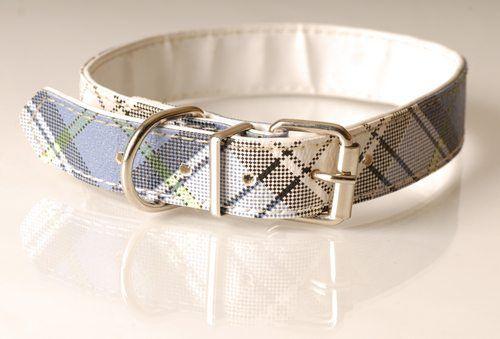
Flat collars are what most people think of traditionally when they think of collars. They can be nylon or leather, buckle or snap, rolled leather or flat.
Limited Slip (Martingale) Collars for Dogs
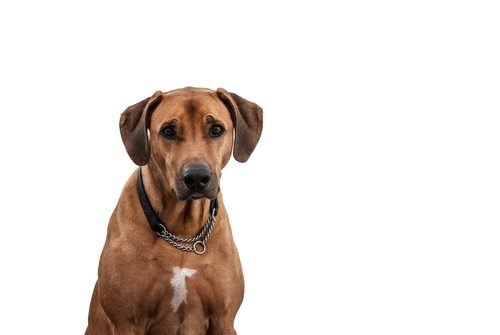
If you have a dog who backs away from situations when unsure or fearful or if you have a “Houdini” dog and the dog has slipped out of her flat collar when the flat collar is adjusted to fit properly, you may consider a limited slip (or martingale) collar. Limited slip collars have found favor with owners of dogs whose necks are approximately the same size as their heads (think Greyhound or Whippet). The limited slip collar works by having one point of attachment for the leash which brings two ends of the collar together. This tightens the collar to a finite size when the leash is pulled. Unlike choke chains (slip collars), the martingale collar cannot tighten indefinitely, but only tightens until the two ends of the collar around the dog’s neck are brought together. The correct size for a dog is when the two sides of the collar (the rings) meet with a two-finger gap between the dog and the collar, like you would fit a flat collar. The limited slip collar may be made of nylon or also contain chain.
Slip (Choke) Collars for Dogs
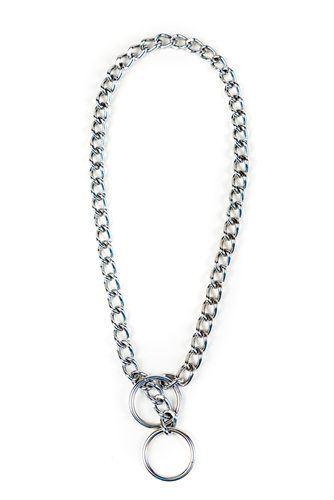
Slip collars are usually made of chain that slips through itself to form a collar. Slip collars are also called choke chains, choke collars, correction collars, or check collars. They are intended to sit high on a dog’s neck, just behind the ears, and to be used only for brief corrections when walking and training a dog. Unlike the martingale or limited slip collar, there is no way to control how much the choke chain tightens, so it’s possible to strangle your dog. It can also cause physical problems, such as injuries to the trachea and esophagus, injuries to blood vessels in the eyes, neck sprains, nerve damage, or fainting. If you use a slip or choke collar, be sure you know how to use this piece of equipment humanely and effectively.
Head Halters for Dogs
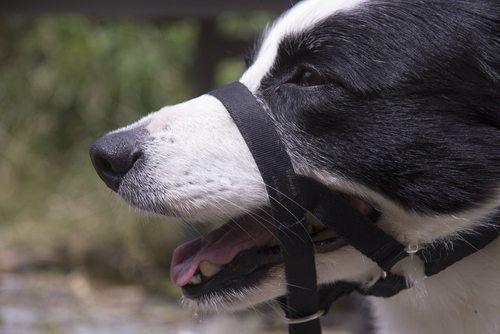
Head halters can be useful training tools for dogs who pull or are very powerful. They fit on the dog’s head and around his nose so when he pulls, his head is turned back to the handler, discouraging pulling. While head halters are permitted by Alliance of Therapy Dogs, they may be best used as a training tool on your way to working in a flat collar, particularly because some members of the public do not understand that they are not muzzles.
Harnesses for Dogs
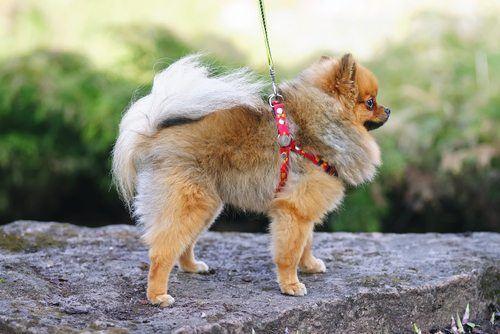
Harnesses wrap around the dog’s chest and can work nicely for dogs who have throat problems. Therapy dogs in harnesses are still expected to walk on a loose leash and not pull the owner down the hallways, so a harness isn’t a quick fix for a small dog who coughs because he’s pulling on his collar. Harnesses can actually make it easier for a dog to pull on the leash – think of sled dogs and horses pulling carriages – they all use harnesses to disburse the weight of what’s being pulled across the entire front of the animal’s body as opposed to just the neck. However, as a training device, a front-clip harness can be helpful to turn the dog’s body back toward the human if and when he pulls.
Therapy dogs who wear a harness or head halter must also wear an approved collar for safety purposes.
Which Collars Does Alliance of Therapy Dogs Not Permit?
Prong Collars for Dogs
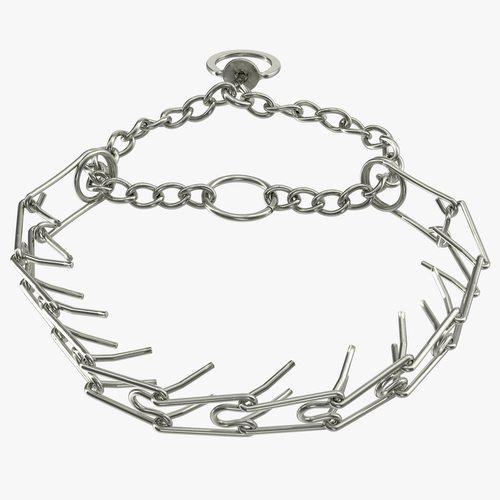
Prong, or pinch, collars can look similar to a limited slip or martingale collar, except they have metal prongs that protrude toward the dog’s throat when the dog wears the collar. These collars are typically made of metal and are NEVER permitted on official therapy dog visits.
Electronic Collars for Dogs
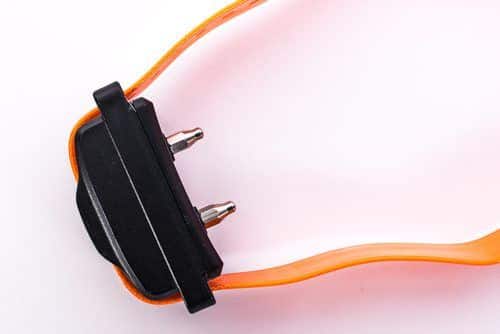
Electronic collars use electric shock, buzzing, beeping, or emission of a spray to let the dog know when it’s done something wrong. Electronic collars can be used to teach dogs boundaries, like with invisible fences, are sometimes used to deter barking, or can be used with a remote control to administer a shock, buzz, or beep at any time. Electronic collars that shock use a battery pack to send electricity through prongs that rest on the dog’s throat. If used, electronic shock collars should be used with extreme caution as they can irritate and inflame your dog’s neck and could result in unintended negative associations with certain circumstances when the shock is administered. Electronic collars are NEVER permitted on official therapy dog visits.
Where to Start?
When considering training equipment, less can be more. Start with a four-foot long leash and a properly-fitting flat collar made of nylon or leather and use positive reinforcement to encourage your dog to walk by your side on a loose leash. In the event you need training “back up,” you can call a reputable trainer or utilize one of the tools in this post to help your dog understand that the best place for her is by your side.
A frequent reason many dogs pull is because they have excess energy. Be sure your dog is getting adequate exercise before obedience training and before a therapy visit to help him focus all of his attention on the task at hand. Most importantly, have fun. Therapy dog work should be an enjoyable experience for you and your dog. Lots of fun and positive practice can help to ensure your visits go smoothly and pleasurably for you and your special dog.

